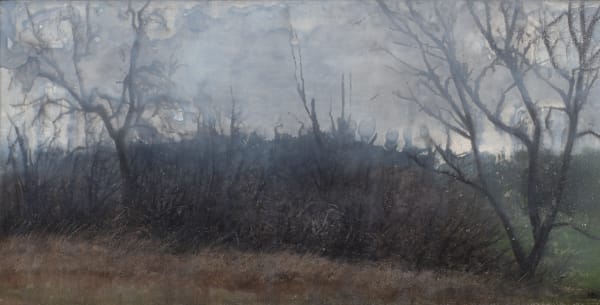Nicholas Blowers: Edgeland
Edgeland was a term coined by the British geographer Marion Shard and it refers to the overlooked places on our doorstep, the urban edge. In our towns and cities it is a place where the urban and rural negotiate and renegotiate their borders. The Tasmanian Edgeland exists in its own unique way and much of it would be familiar the world over; the dilapidated remnants of human endeavour are there to be found alongside the mental asylums, Retail Parks, ruins, recycling centres, wasteland and bridges with “scribble pad” tagging on their pylons. If our early years form our imagination then mine was formed in places such as these. The Edgeland was where you played and sought out adventure, the outskirts of town offered the promise of mystery. It is far removed from the “heritage core” of the inner city or the important "getaway" destinations of established beauty. It doesn't offer the promise of Heritage walks, Coastal walks, Bush walks or Art walks. And it doesn't have the sanctioned access of the landscaped council park. To be observed enjoying these places engenders no suspicion at all but it is a very different story when wandering on the fringe. Observe the expression on the face of the car driver when he passes you on the main Road out of town as you stroll down a well-worn “desire path” into scrub land and it says “up to no Good!”. And why would you be skirting the boundary of a retail park or semi-derelict mental asylum with your camera? In fact to take a walk outside of the urban centre into the fringe of any town and city is often to be met with barbed wire and suspicion; A slightly subversive pursuit, where it is possible to find a unique feeling of remoteness.
Over the past winter I have undertaken a number of walks and often the things I have observed on those trips; buildings, bridge pylons or man-made structures are weathered and scarred with the vagaries of life and reflect my interest in the grubby and prosaic. The neo-romantic painter, John Piper, described the act of civilisation being claimed back by nature as the “pleasing state of decay.” These places are imbued with a sense of the previous inhabitants and show people’s lives continuing to play out against them.
Within the overlooked and marginal places of the city there is a great tradition in wandering and observing. It is possible to reconnect with an earlier literary tradition via contemporary writers Ian Sinclair, Stuart Home and the historian Peter Acroyd to writers such as Daniel Defoe, William Blake, Thomas de Quincey and Robert Louis Stevenson. The Psychogeographer Ian Sinclair's book “London Orbital” traces a journey he made on foot circling the M25 and it is this change of geographical focus and imaginative reworking of the city that interests me. Within this tradition there is mystery beneath the apparently banal surfaces of everyday life and the focus is often on the fringe elements of the city. These writers have in common a connection with London, of urban and rural wandering and often employ Gothic imagery to symbolise the mystery beneath the modern city.
-
 Nicholas BlowersFreestyle, 2013oil on paper, framed61 x 104cmSold
Nicholas BlowersFreestyle, 2013oil on paper, framed61 x 104cmSold -
 Nicholas BlowersBrewery, 2013oil on paper, framed89 x 85cmSold
Nicholas BlowersBrewery, 2013oil on paper, framed89 x 85cmSold -
 Nicholas BlowersAsylum Bridge, New Norfolk, 2013oil on paper, framed48 x 79cmSold
Nicholas BlowersAsylum Bridge, New Norfolk, 2013oil on paper, framed48 x 79cmSold -
 Nicholas BlowersBreaststroke, 2013oil on paper, framed61 x 80cmSold
Nicholas BlowersBreaststroke, 2013oil on paper, framed61 x 80cmSold -
 Nicholas BlowersDF + JD, 2013oil on paper, framed108 x 108cmSold
Nicholas BlowersDF + JD, 2013oil on paper, framed108 x 108cmSold -
 Nicholas BlowersJordan River Bridge Pylon, 2013oil on paper, framed57 x 104cmSold
Nicholas BlowersJordan River Bridge Pylon, 2013oil on paper, framed57 x 104cmSold -
 Nicholas BlowersUrban Occult Markings, 2013oil on paper, framed57 x 104cmSold
Nicholas BlowersUrban Occult Markings, 2013oil on paper, framed57 x 104cmSold -
 Nicholas BlowersTower, 2013oil on canvas, framed81 x 75cmSold
Nicholas BlowersTower, 2013oil on canvas, framed81 x 75cmSold -
 Nicholas BlowersShadow Man, Winter morning, 2013oil on canvas, framed85 x 62 cm overallSold
Nicholas BlowersShadow Man, Winter morning, 2013oil on canvas, framed85 x 62 cm overallSold -
 Nicholas BlowersThe Wall, 2013oil on canvas, framed91.5 x 105cm overallSold
Nicholas BlowersThe Wall, 2013oil on canvas, framed91.5 x 105cm overallSold -
 Nicholas BlowersRoad Stop, 2013oil on canvas, framed61.5 x 78 cm overallSold
Nicholas BlowersRoad Stop, 2013oil on canvas, framed61.5 x 78 cm overallSold -
 Nicholas BlowersDownpour, 2013oil on canvas, framed85 x 62 cm overallSold
Nicholas BlowersDownpour, 2013oil on canvas, framed85 x 62 cm overallSold -
 Nicholas BlowersTangled Copse, New Norfolk, 2013oil on canvas, framed85 x 62 cm overallSold
Nicholas BlowersTangled Copse, New Norfolk, 2013oil on canvas, framed85 x 62 cm overallSold -
 Nicholas BlowersTree. Storm. Sun, 2013oil on canvas, framed26 x 32 cm overallSold
Nicholas BlowersTree. Storm. Sun, 2013oil on canvas, framed26 x 32 cm overallSold -
 Nicholas BlowersNew Norfolk Block, Winter, 2013oil on canvas, framed26 x 32 cm overallSold
Nicholas BlowersNew Norfolk Block, Winter, 2013oil on canvas, framed26 x 32 cm overallSold -
 Nicholas BlowersCopse, New Norfolk, 2013oil on canvas, framed23 x 42.5 cm overallSold
Nicholas BlowersCopse, New Norfolk, 2013oil on canvas, framed23 x 42.5 cm overallSold -
 Nicholas BlowersWillow Court, 2013oil on canvas, framed23 x 32.5 cm overallSold
Nicholas BlowersWillow Court, 2013oil on canvas, framed23 x 32.5 cm overallSold


















